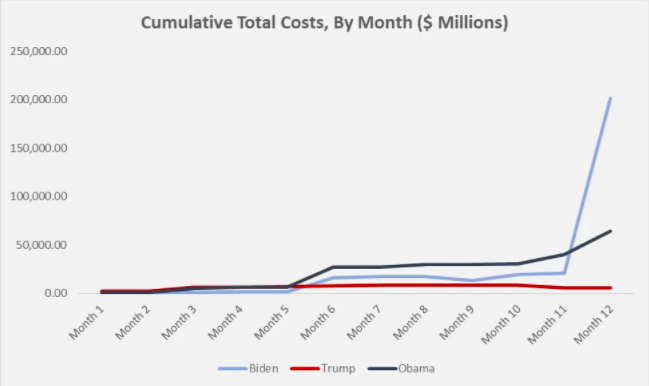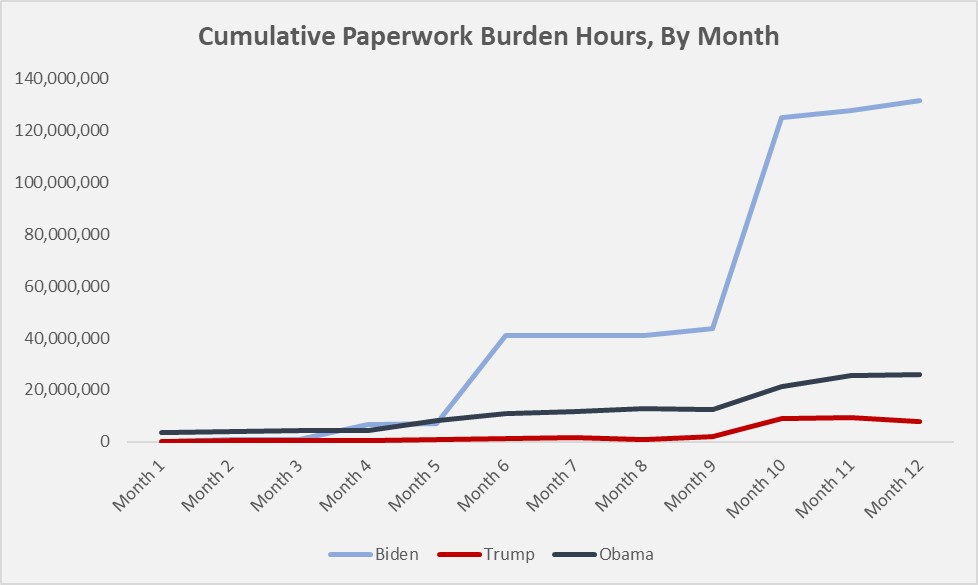President Joe Biden has blown past both Presidents Barack Obama and Donald Trump in adding regulatory costs in his first year, a new analysis shows.
The Biden administration is finishing off its first full year in office with more than $201 billion in regulatory costs and approximately 131 million hours in new annual paperwork, according to research by the American Action Forum, a conservative think tank that closely tracks government rule-making.
Biden’s regulatory costs are three times those added in Obama’s inaugural year and nearly 40 times more than in Trump’s first year, the group found. Additionally, Biden’s 131 million hours in annual paperwork attached to its regulations blew past the totals from Trump and Obama by 123 million and 105 million hours, respectively.

AAF noted in its research that the single biggest regulatory change during Biden’s first year, which came near the end of 2021, was a rule that changed tailpipe emission requirements for new cars, trucks, and SUVs.
STOCKS PLUMMET AS FED GEARS UP TO RAISE INTEREST RATES FOR FIRST TIME IN YEARS
The rule requires automakers to meet a fleetwide average of 55 mpg by 2026 — a significant jump from the 38 mpg average required today and higher than the 43 mpg standard the Trump administration set for 2026.
The total cost of the rule change is expected to be about $180 billion, which makes it the most expensive final rule tracked by the AAF since 2005, the group said. In fact, Biden’s inaugural year in terms of regulatory costs would have fallen to second place behind Obama’s first year had that rule not been approved.
The next costliest regulation was a rule to restrict surprise billing for patients in individual and job-based healthcare plans “who receive emergency care, nonemergency care from out-of-network providers at in-network facilities, and air ambulance services from out-of-network providers.” The cost of that regulation, which was mandated by bipartisan legislation signed by Trump, is about $10.5 billion, according to the group.
An emergency temporary standard rule from the Occupational Safety and Health Administration to protect healthcare and healthcare support service workers from occupational exposure to the coronavirus has an expected cost of nearly $4 billion.
Much of the paperwork burden associated with regulatory changes during Biden’s first year is related to the COVID-19 pandemic.
The $4 billion COVID-19 regulation would yield roughly 19.3 million hours of paperwork, according to the Department of Labor.
Another emergency temporary standard that mandated businesses with more than 100 employees require vaccination or weekly testing was estimated to yield 80 million hours of paperwork and cost $3 billion, although the mandate was struck down by the Supreme Court earlier this month.

In a broader sense, Wayne Crews, vice president for policy at the Competitive Enterprise Institute, told the Washington Examiner that one of the biggest changes since Biden took office was ending Trump’s “one-in, two-out” executive order that directed agencies to repeal two existing regulations for every new one and keep costs low. Biden cast that policy out the door on his way into the Oval Office.
Crews said that Biden has worked to expand the regulatory state since being sworn in and, in a recent article about regulations since Biden has taken office, Crews said that the president didn’t just toss Trump’s deregulatory agenda to the side but instead “hurled it away with great force, systematically revoking it in word and deed.”
Looking ahead, Biden is set to revamp environmental regulations that were changed under Trump. Upon entering office last January, the administration laid out a road map for pausing implementation of more than 100 Trump-era environmental policies that were under review, with Biden signing an executive order to do so.
Crews noted that one tool at Biden’s disposal has been the Congressional Review Act, which allows new legislatures to repeal rules and regulations made during a “look-back” period dating back to the prior 60 legislative days of the previous administration. He said that up until Trump, the act had only been used once, but Trump used it 16 times to get rid of Obama-era rules, and Biden followed suit and used the mechanism three times during his first year to roll back Trump-era regulations.
Biden used the act to do away with the so-called true lender rule that the Office of the Comptroller of the Currency finalized in late 2020. He did the same with an Equal Employment Opportunity Commission rule and also used it to reverse Trump’s rollback of the emissions rule.
Two pieces of legislation that will lead to considerable new additions to the Federal Register are the partisan COVID-19 relief bill passed at the outset of Biden’s term and the bipartisan infrastructure bill passed last year. Crews pointed out that the rule-making process can take weeks, months, or years, depending on the nature of the individual regulation.
While Democrats on Capitol Hill are likely to be pleased with Biden’s shift away from Trump’s deregulatory agenda, Republicans fear that Biden will use the rule-making process to circumvent Congress and enact regulation as a go-around for failed legislation such as the Build Back Better plan.
During a phone call with reporters Wednesday, Rep. Kevin Brady, the top Republican on the powerful Ways and Means Committee, said he feared “a tsunami of new regulations.”
The Texas Republican said he fears that Biden, because of the system of checks and balances in place and because of his inability to garner congressional support for some of his priorities, will turn to the regulatory side in order to circumvent the legislative process.
“He has a number of regulations focused on greenhouse gas emissions in the Green New Deal that don’t have bipartisan support, that haven’t been fully vetted, and I think could increase the burden on job creators in the U.S.,” Brady said in response to a question from the Washington Examiner.
CLICK HERE TO READ MORE FROM THE WASHINGTON EXAMINER
AAF said that taken in its totality, Biden’s first year in office represented a “historically prodigious year in the realm of regulatory activity.”
“With much of his legislative agenda stalling, a trend that is unlikely to be reversed quickly, one can expect this historic pace of executive action to continue, if not increase, heading into 2022,” the researchers concluded.





